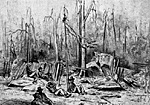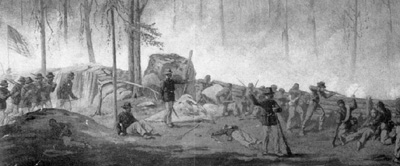
With due apologies to Mr. Lincoln, the Civil War Brigade Series has indeed become the system of the last five years to game Civil War battles. No other game boasts the unique command and control mechanics and the heroic morale states. We game it and we love it. We also use some house rules to add a certain flavor to the experience. Some we have borrowed from other Operations articles; some we have devised ourselves. We hope this article sparks dialogue among Civil War gamers and a sense of experimentation as you try these rules in your games. Please contact us through The Gamers if you have any comments on these proposals as rule changes or optional rules.
The Dreaded Army Headquarters
Players may establish Army HQ anywhere. However, add a +1 column shift to the acceptance of any written order to represent staff planning and organization if you establish HQ in a building or barn, etc.
To move Army HQ, the army commander gives an IPV order and his subordinates automatically accept it. Mark the HQ with an A symbol-the HQ is packing, preparing to move, etc. This takes one turn. The HQ then moves to its next location in the next turn(s). The following turn, after it moves, mark it with a B symbol as the Army HQ is now unpacking and setting up shop. At the end of this turn, remove the B symbol and the HQ functions normally.
Councils of War that involve multiple orders can now only take place at Army HQ. While the Army HQ is marked with a symbol, you may not send written orders. (For those that feel this is too strict, use a two column shift.) We feel that this penalty forces players to plan and choose strategic siting on arrival for their Army HQ. We feel that this rule simply and elegantly places the importance of the Army HQ back in CWB.
 0rders
0rders
Army commanders now can only issue one IPV to a corps commander per turn. We feel this seemingly small restriction will bring an end to the large roving stacks of leaders that sometimes occur in CWB games. It will also bring written orders and aide oral orders back to the table as a usable tool, especially when coupled with our HQ rule and our proposed change in orders cost (see below).
Like everyone else, all our orders are Force 2. We agree that this is not in character with the era or many of the personalities. We propose the following changes to order costs so the player thinks twice about sending F2 orders all the time. Now, an FO costs 0 points, an Fl costs 2 points, and an F2 costs 6 points. See below for comparative costs:
| Complex, written | Complex, oral |
|---|---|
| 8 CP at F0 | 5 CP at F0 |
| 10 CP at F1 | 7 CP at F1 |
| 14 CP at F2 | 11 CP at F2 |
By just changing the cost of Force 2 orders, players now face real tradeoffs in command with no additional bookkeeping, point tracking, etc. The integrity of the order system remains in place. Try these new orders cost with commanders like Grant, Lee or Bragg, and you will see many subtle tradeoffs and choices.
Combat Tables
We just finished ITQF using the Napoleonic charts adapted to CWB. After much discussion, we decided we liked the old charts better. The new ones were not much faster and we are creatures of habit. However, we would like to see two changes made to the existing tables: separate fire columns for the 3/4 and 5/6 point columns on the Fire Combat Table, the rest stays as is.
Also, have two sets of modifiers for the combat tablescolumn shift modifiers and die roll modifiers. The column shift modifiers remain the same. The die roll modifier chart looks lie this:
- -1 Fire into a breastworks hexside
-1 Small arms fire UP an elevation
-1 Small arms fire into a woods or rough hex
+1 Artillery into AA or larger
These modifiers encourage players to occupy ridge lines and disperse large units. They do not encourage them to form line in woods for the correct historical reason (see below).
Morale Table
Why mess with a good thing? We will not, except that any unit taking a morale check in a woods or rough hex as a result of fire suffers a -2 column shift. There are no -2 shifts so it is easy to remember and apply. Lack of command and control was the real fear for fighting in woods/rough terrain. In any account on battles like Shiloh, Chickamauga or The Wilderness, lack of command and control comes up repeatedly. This is a simple and elegant way to make the players weigh the trade-off of that - I die roll modifier for forming or attacking through woods hexes. Generally, it is not worth it, but now the players make the choice.
Combat
Only one change: only artillery positioned on higher ground is able to fire over the heads of adjacent infantry units at one half strength. We just came up with this one and have not used it much yet. But we feel the system cries out for this rule as there are no opportunity fire rules at this scale. The gun loss table can be brutal, and this change gives a simple yet effective way to work in more Civil War command choices. This rule also encourages the player to seek out high ground. Through repeated play, we have found our gun losses are too high compared to the historical counterpart. This gives the player another option, yet at a significant cost in firepower.
Fatigue
We believe a game at this scale definitely deserves fatigue rules. We are currently using the fatigue rules proposed in Philip Cutajar's "The Fog of Battle and Other Factors" (Operations 17) at the Divisional level with success. They force players to conserve troops and troop movement further in preparation for later activities.
Special Cavalry Rules
Allow cavalry to extend line out two hexes on either side. Also, cavalry can elect to screen. To screen, the cavalry line retreats one hex before combat. This includes close combat and affects the entire line of that brigade. This permits cavalry to screen and delay while absorbing some casualties, yet it allows opposing infantry the ability to drive cavalry. Again, this rule puts choices into the players' hands.
Extended Movement
Last but certainly not least, extended movement is one of our favorite rules in CWB. In no other game can players make flanking marches. However, Dean and I tend to use extended movement, especially at night, as if we have LANDSAT satellites orbiting over Gettysburg. We propose the following changes to the extended movement rules. As long as the units using extended movement remain on roads or use it in daytime, there is no change. However, if they use it at night and leave the road net, apply the following rule.
Roll one die for each turnoff road. Consult the table. Apply the results. Repeat for each turn off road.
| Die Roll | Movement Points |
|---|---|
| 1 | 4 MP |
| 2 | 3 MP |
| 3 | 3 MP |
| 4 | 2 MP |
| 5 | 0 MP (lost) |
| 6 | 0 MP (lost) |
There is a +1 modifier if moving in non-clear terrain.
This still allows the player to take a chance at that surprise flanking march that bursts out of the woods at 7:00 a.m. but also adds a great deal of risk-maybe I should stay on that road to deploy the corps easier (and by the way-play with the road column rule). We originally messed with a rosette on a die roll of a 5 or 6 so that units would go off in different directions but we had trouble sorting it out. If anyone has any ideas on it...
So, there it is: further tinkering with one of the best gaming systems on the market. Try these out at your next CWB gaming session and let us know what you think.
Back to Table of Contents -- Operations #19
Back to Operations List of Issues
Back to MagWeb Master List of Magazines
© Copyright 1995 by The Gamers.
This article appears in MagWeb (Magazine Web) on the Internet World Wide Web.
Other military history articles and gaming articles are available at http://www.magweb.com